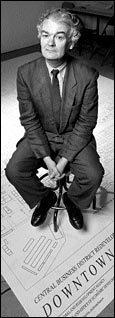Envisioning a 'There' There
CED Revitalization Plan Would Bring 10,000 New Residents to Downtown Oakland
By Fernando Quintero, Public Affairs
Posted May 5, 1999
 Associate Professor Peter Bosselmann. Noah Berger photo. |
Now a new study by the College of Environmental Design aims to reverse the trend -- with a revitalization plan for the City of Oakland that would bring 10,000 new residents to its downtown area.
"In the last 50 years, land development has been done in a wasteful fashion," said Peter Bosselmann, associate professor of city and regional planning, who conducted the study with the aid of several students. "In bringing back the population to downtown Oakland, we're bringing about the sustainability of a major metropolitan region."
The plan calls for development of higher-density housing mixed with some commercial use, taking advantage of downtown Oakland's many existing amenities.
"The area is transit rich -- BART, busses, a train station -- one of the most important attractions for downtown Oakland," said Bosselmann. The study area is bordered by the Port of Oakland, Lake Merritt, the Oakland Museum and Laney College.
In addition, Bosselmann said the area has an important, historic commercial district in Chinatown.
The study excludes most of the existing housing in the area. "It's a small but special community that should be left intact," said Bosselmann.
The study was commissioned by Oakland Mayor Jerry Brown, a strong supporter of downtown redevelopment. City officials approached Bosselmann because "planning analysis is no longer a routine part of the city planning staff," he said.
An oversized map of the study area lies in a corner of the College of Environmental Design's Environmental Simulation Laboratory, a state-of-the-art research facility that produces models and highly realistic visual simulations of environments.
A red-roofed model of a housing complex that would contain 100 household units represents 60 residences per acre. These buildings would be mostly residential units, with little commercial space and limited parking. Municipal garages would be strategically located throughout the area for residents as well as visitors. At other locations on the map, taller match box-size models of housing complexes represent about 120 more residential units, many with retail units on the ground floor.
Some of the challenges Bosselmann sees in bringing 10,000 people to downtown Oakland would include acquiring the land, much of which is privately owned. Also, developers would have to look at the area to determine financing feasibility. Bosselmann said students are already conducting marketing studies to address such concerns.
"It can be done," said Bosselmann. "Compared with other world cities, there's room to spare."
![]()
![]()
May 5 - 11, 1999 (Volume 27, Number 33)
Copyright 1999, The Regents of the University of California.
Produced and maintained by the Office of Public Affairs at UC Berkeley.
Comments? E-mail berkeleyan@pa.urel.berkeley.edu.